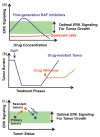Targeting Aberrant RAS/RAF/MEK/ERK Signaling for Cancer Therapy
- PMID: 31941155
- PMCID: PMC7017232
- DOI: 10.3390/cells9010198
Targeting Aberrant RAS/RAF/MEK/ERK Signaling for Cancer Therapy
Abstract
The RAS/RAF/MEK/ERK (MAPK) signaling cascade is essential for cell inter- and intra-cellular communication, which regulates fundamental cell functions such as growth, survival, and differentiation. The MAPK pathway also integrates signals from complex intracellular networks in performing cellular functions. Despite the initial discovery of the core elements of the MAPK pathways nearly four decades ago, additional findings continue to make a thorough understanding of the molecular mechanisms involved in the regulation of this pathway challenging. Considerable effort has been focused on the regulation of RAF, especially after the discovery of drug resistance and paradoxical activation upon inhibitor binding to the kinase. RAF activity is regulated by phosphorylation and conformation-dependent regulation, including auto-inhibition and dimerization. In this review, we summarize the recent major findings in the study of the RAS/RAF/MEK/ERK signaling cascade, particularly with respect to the impact on clinical cancer therapy.
Keywords: BRAF(V600E); RAF inhibitors; RAS GTPases, RAF family kinases; Ras/RAF/MEK/ERK signaling; neoplasm; paradoxical activation; protein–protein interactions; synthetic lethal.
Conflict of interest statement
The authors declare no conflicts of interest. The funders had no role in the design of the study; in the collection, analyses, or interpretation of data; in the writing of the manuscript, or in the decision to publish the results.
Figures





References
Publication types
MeSH terms
Substances
LinkOut - more resources
Full Text Sources
Other Literature Sources
Medical
Research Materials
Miscellaneous

